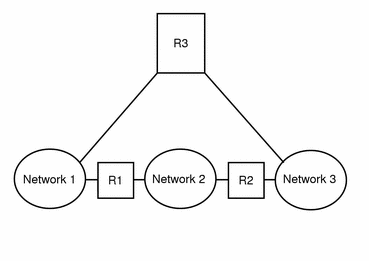Network Topology
Network topology describes how networks fit together. Routers are the entities that connect networks to each other. From a TCP/IP perspective, a router is any machine that has two or more network interfaces. However, the machine cannot function as a router until properly configured, as described in Chapter 5, Configuring Routers.
Two or more networks can be connected together by routers to form larger internetworks. The routers must be configured to pass packets between two adjacent networks. They also should be able to pass packets to networks that lie beyond the adjacent networks.
Figure 3-5 shows the basic parts of a network topology. The first illustration shows a simple configuration of two networks connected by a single router. The second shows a configuration of three networks, interconnected by two routers. In the first case, network 1 and network 2 are joined into a larger internetwork by router R. In the second case, router R1 connects networks 1 and 2, and router R2 connects networks 2 and 3, thus forming a network made up of networks 1, 2, and 3.
Figure 3-5 Basic Network Topology

Routers join networks into internetworks and route packets between them based on the addresses of the destination network. As internetworks grow more complex, each router must make more and more decisions regarding where packets are to be sent.
A step up in complexity is the case shown in Figure 3-6. Networks 1 and 3 are directly connected by a router R3. The reason for such redundancy is reliability. If network 2 goes down, router R3 still provides a route between networks 1 and 3. Any number of networks can be interconnected and communicate as long as they all adhere to the same network protocols.
Figure 3-6 Providing an Additional Path Between Networks

- © 2010, Oracle Corporation and/or its affiliates
